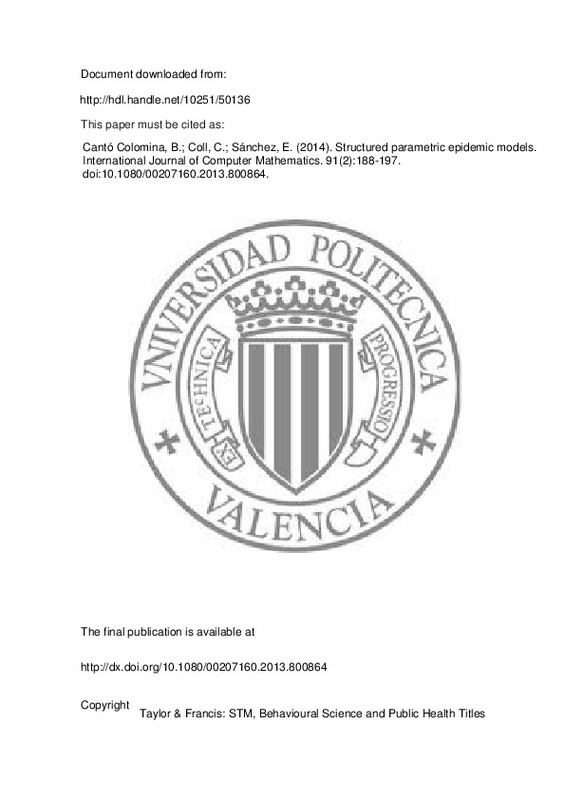Allen, L. J. S., & Thrasher, D. B. (1998). The effects of vaccination in an age-dependent model for varicella and herpes zoster. IEEE Transactions on Automatic Control, 43(6), 779-789. doi:10.1109/9.679018
Ben-Zvi, A., McLellan, P. J., & McAuley, K. B. (2004). Identifiability of Linear Time-Invariant Differential-Algebraic Systems. 2. The Differential-Algebraic Approach. Industrial & Engineering Chemistry Research, 43(5), 1251-1259. doi:10.1021/ie030534j
Boyadjiev, C., & Dimitrova, E. (2005). An iterative method for model parameter identification. Computers & Chemical Engineering, 29(5), 941-948. doi:10.1016/j.compchemeng.2004.08.036
[+]
Allen, L. J. S., & Thrasher, D. B. (1998). The effects of vaccination in an age-dependent model for varicella and herpes zoster. IEEE Transactions on Automatic Control, 43(6), 779-789. doi:10.1109/9.679018
Ben-Zvi, A., McLellan, P. J., & McAuley, K. B. (2004). Identifiability of Linear Time-Invariant Differential-Algebraic Systems. 2. The Differential-Algebraic Approach. Industrial & Engineering Chemistry Research, 43(5), 1251-1259. doi:10.1021/ie030534j
Boyadjiev, C., & Dimitrova, E. (2005). An iterative method for model parameter identification. Computers & Chemical Engineering, 29(5), 941-948. doi:10.1016/j.compchemeng.2004.08.036
Cantó, B., Coll, C., & Sánchez, E. (2011). Identifiability for a Class of Discretized Linear Partial Differential Algebraic Equations. Mathematical Problems in Engineering, 2011, 1-12. doi:10.1155/2011/510519
Cao, H., & Zhou, Y. (2012). The discrete age-structured SEIT model with application to tuberculosis transmission in China. Mathematical and Computer Modelling, 55(3-4), 385-395. doi:10.1016/j.mcm.2011.08.017
Diekmann, O., Heesterbeek, J. A. P., & Metz, J. A. J. (1990). On the definition and the computation of the basic reproduction ratio R 0 in models for infectious diseases in heterogeneous populations. Journal of Mathematical Biology, 28(4). doi:10.1007/bf00178324
Dion, J.-M., Commault, C., & van der Woude, J. (2003). Generic properties and control of linear structured systems: a survey. Automatica, 39(7), 1125-1144. doi:10.1016/s0005-1098(03)00104-3
Emmert, K. E., & Allen, L. J. S. (2004). Population Persistence and Extinction in a Discrete-time, Stage-structured Epidemic Model. Journal of Difference Equations and Applications, 10(13-15), 1177-1199. doi:10.1080/10236190410001654151
Farina, L., & Rinaldi, S. (2000). Positive Linear Systems. doi:10.1002/9781118033029
Van den Hof, J. M. (1998). Structural identifiability of linear compartmental systems. IEEE Transactions on Automatic Control, 43(6), 800-818. doi:10.1109/9.679020
T. Kailath,Linear Systems, Prentice-Hall, Englewood Cliffs, NJ, 1980.
Li, C.-K., & Schneider, H. (2002). Applications of Perron-Frobenius theory to population dynamics. Journal of Mathematical Biology, 44(5), 450-462. doi:10.1007/s002850100132
Li, X., & Wang, W. (2005). A discrete epidemic model with stage structure☆. Chaos, Solitons & Fractals, 26(3), 947-958. doi:10.1016/j.chaos.2005.01.063
Ma, J., & Earn, D. J. D. (2006). Generality of the Final Size Formula for an Epidemic of a Newly Invading Infectious Disease. Bulletin of Mathematical Biology, 68(3), 679-702. doi:10.1007/s11538-005-9047-7
Wang, W., & Zhao, X.-Q. (2004). An epidemic model in a patchy environment. Mathematical Biosciences, 190(1), 97-112. doi:10.1016/j.mbs.2002.11.001
[-]







![[Cerrado]](/themes/UPV/images/candado.png)


